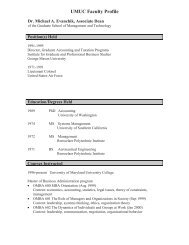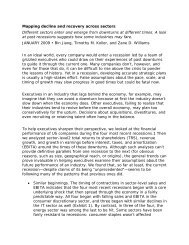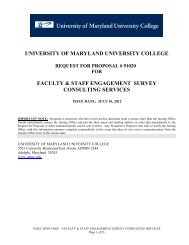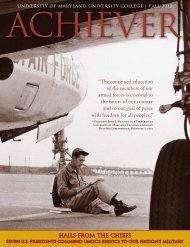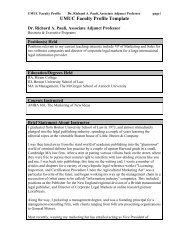LITTLE-kNowN FAcTS ABoUT ARTISTS wITH - UMUC
LITTLE-kNowN FAcTS ABoUT ARTISTS wITH - UMUC
LITTLE-kNowN FAcTS ABoUT ARTISTS wITH - UMUC
Create successful ePaper yourself
Turn your PDF publications into a flip-book with our unique Google optimized e-Paper software.
STEVEN HALPErSoN, TISArA PHoToGrAPHy<br />
The recent loss of my dear friend and colleague<br />
of more than 20 years has prompted me to reflect<br />
on his life and legacy. It is with both a sad heart<br />
and a profound pride that I share my recollections<br />
and memories of Larry Chappelear. He was, first,<br />
my friend, but so much more: a colleague,<br />
a teacher, and an artist.<br />
As a colleague at the College of Southern Maryland<br />
(CSM), Larry was always engaged, fair, and<br />
understanding. He was a champion for the issues<br />
we faced together: advancing the arts program,<br />
setting the highest standards of teaching, and<br />
furthering a fundamental appreciation of the arts.<br />
We worked in tandem to develop a quality reputation<br />
for the CSM gallery, recruiting top-level artists<br />
for exhibitions. The goal for us was to bring in<br />
artists of high caliber from across the country and<br />
around the world. It wasn’t always easy to stick to<br />
our goal, but Larry’s honest and straightforward<br />
approach, along with a marvelous sense of humor,<br />
saw us through many awkward moments.<br />
As a teacher, Larry conveyed his passion for and<br />
love of the arts to his students. His extraordinary<br />
talent and unyielding commitment to his personal<br />
page 2 • www.umuc.edu/art<br />
Remembering Larry Chappelear<br />
BY BARBARA STEPhANIC, PhD<br />
art became an inspiration, and he became a role<br />
model to so many. Teaching provided him a<br />
stimulating forum for his ideas and an opportunity<br />
to share his enthusiasm for art. He taught<br />
his students more than the mechanics of putting<br />
ideas on a two-dimensional surface; he showed<br />
them how to see objects with a discerning eye<br />
and to reach for their individual creativity. Students<br />
benefitted from his experience, his originality, and<br />
his innovative vision while learning to respect the<br />
process, technique, and subject matter of the<br />
work they created.<br />
It is, perhaps, the art of Larry Chappelear that<br />
will be remembered and held in high regard by<br />
most. Those who did not know him personally<br />
will know the incredible sensitivity of this artist<br />
from his paintings. As an outdoorsman, Larry had<br />
a special relationship to the landscape. He had an<br />
exceptional ability to keenly observe the seasonal<br />
changes in nature, each with its own freshness<br />
and spectacular painterly beauty. He most often<br />
painted outdoors from direct observation, capturing<br />
the artistic elements in nature. His landscape<br />
paintings provide a visual diary of his experiences<br />
and speak to his passion and creative responses<br />
to the environment around him. His compositions<br />
unify the complex elements in nature into<br />
a panorama of harmony and balance. Each is a<br />
testimony to his intrinsic understanding of solid<br />
forms and empty spaces and his unique ability<br />
to organize form, color, space, and light. Larry was<br />
successful in his effort to, as he said, “capture the<br />
viewer by transforming the openness of a field<br />
into an intimate space.” He had a unique ability to<br />
share, through his paintings, a feeling of serenity<br />
and solitude with others.<br />
Early in this century, Larry experienced a pivotal<br />
change in his interpretation of the landscape. He<br />
moved from the specificity of realism to experimenting<br />
with the mysterious and metaphorical<br />
characteristics of abstraction. The landscape continued<br />
to be his inspiration, but now he saw more<br />
provocative elements prevalent in nature. It was<br />
the new, bold, abstract collage and assemblage<br />
that came to the attention of Marilyn Hart, then<br />
assistant vice president of the Arts Program at<br />
<strong>UMUC</strong>, who subsequently arranged an exhibition<br />
of his new work. The exhibition included both his<br />
traditional landscapes and the new abstract work.<br />
I had the extraordinary good fortune to be invited<br />
Above, Left: Larry Chappelear<br />
Above, Right: Larry Chappelear, Window Still Life III (detail), 2008, assemblage mixed media<br />
HENry TrENTMAN<br />
to write the essay for the exhibition and the privilege<br />
to work closely with Larry for nearly a year<br />
in preparation. We spent many hours talking about<br />
the fundamental principles of art making and the<br />
specifics of his ideas for composition, color theory,<br />
and conveyance of the basic elements of nature<br />
in abstract forms. While we talked, he often would<br />
continue painting, and I could see the excitement<br />
build as he worked tirelessly on a composition,<br />
studying and reworking the forms until he was<br />
satisfied. I researched and studied the history<br />
of American landscape painting and the evolution<br />
of abstract art so as to best explain Larry’s<br />
ideas—the content of his paintings, iconography,<br />
and style. His latest work combines the traditional<br />
structure in landscape representation with the bold<br />
colors and strong lines in abstract interpretations.<br />
<strong>UMUC</strong> ADDS TO ITS<br />
PERMANENT COLLECTIONS<br />
The Arts Program would like to thank Beverly<br />
Corey and Iver Nelson, who recently donated<br />
works of art to <strong>UMUC</strong>. Due to the generosity<br />
of such patrons, the collections at the university<br />
continue to grow and now include more<br />
than 1,800 works.<br />
Corey donated Generation by Preston Sampson.<br />
This large painting is reflective of Sampson’s<br />
colorful and fluid artistic style. Sampson’s work<br />
might be best known from a commission by<br />
Absolut Vodka for a series of paintings for its<br />
1997 advertising campaign, which traveled to<br />
various exhibition venues. Sampson was also<br />
awarded a professional travel grant to Spain,<br />
and the trip inspired him to incorporate the<br />
human torso into his artwork, perhaps influ-<br />
INFLUENCE OVER TIME:<br />
ThE ART OF WINSTON hARRIS<br />
Influence over Time: The Art of Winston Harris<br />
is a reflection of Harris’s sustained interest in<br />
the notion of the unending passage of time and<br />
the roles that overt status symbol timepieces,<br />
such as rolex watches, play in contemporary<br />
culture. These screenprint and digital hybrids<br />
will be on view Monday, February 20, 2012,<br />
through the summer, on the second floor gallery<br />
of the <strong>UMUC</strong> Inn and Conference Center.<br />
I will be forever grateful to Larry for all he taught<br />
me about art, for his remarkable and intuitive<br />
sense of aesthetic, and for his gentle kindness.<br />
The legacy he leaves in his paintings will continue<br />
to give pleasure to and captivate all those who<br />
see them. I will think of him whenever I see a<br />
spectacular red and yellow sunset, a cloud formation<br />
against a cobalt blue sky, or a lone tree in a<br />
vast green meadow. He left us all with a new way<br />
of seeing and appreciating the landscape.<br />
But, most of all I am grateful for his endearing<br />
friendship and steadfast loyalty.<br />
Barbara Stephanic, PhD, is past vice chair and honorary<br />
member of the <strong>UMUC</strong> Art Advisory Board.<br />
She was a professor of art history at the College<br />
of Southern Maryland until her retirement.<br />
encing a work such as Generation. Works by<br />
Sampson can be found in many public and<br />
private collections throughout the country,<br />
including the Jean and robert Steele Collection,<br />
the Darryl Walker Collection, the Tubman<br />
African American Museum, and the David C.<br />
Driskell Collection at University of Maryland,<br />
College Park.<br />
Iver Nelson, an esteemed Asian art collector,<br />
donated 15 works of art to <strong>UMUC</strong>’s Asian<br />
Collections. Nelson, who had amassed a large<br />
collection of rare works over the years, has<br />
donated exceptional pieces to the Art Institute<br />
of Chicago, the Indianapolis Museum of Art,<br />
and the Minneapolis Institute of Arts. The oldest<br />
work Nelson donated to <strong>UMUC</strong> is from the Tang<br />
Dynasty (618–907 AD). The piece is a kneeling<br />
Bactrian camel, and is prized for its elegant movement<br />
and naturalism.<br />
Harris is a Washington, D.C., area artist who, supported<br />
by a Prince George’s Arts and Humanities<br />
Council grant, collaborated with the printmaking<br />
department at University of Maryland, College<br />
Park in 2010. Harris worked with assistant professor<br />
Justin Strom and students to create a new<br />
series of flat and sculptural prints.<br />
Known primarily as a printmaker, Harris holds a<br />
BFA in printmaking from Howard University and<br />
an MFA in printmaking from Virginia Commonwealth<br />
University.<br />
Above: Larry Chappalear, Sycamore, 2004,<br />
mixed media on panel, 32 x 30 in.<br />
Above, top: Preston Sampson, Generation (detail), 1999,<br />
mixed media / Above, bottom: Bactrian camel, Early Tang<br />
Dynasty, earthenware with pigments, 13½ x 1½ x 8½ in.<br />
Above: Winston Harris, Military Time,<br />
2009, oil stick and print, 36 x 29¾ in.<br />
www.umuc.edu/art • page 3<br />
STEVEN HALPErSoN, TISArA PHoToGrAPHy HENry TrENTMAN





